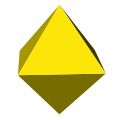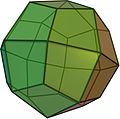Expanded cuboctahedron
The expanded cuboctahedron is a polyhedron constructed by expansion of the cuboctahedron. It has 50 faces: 8 triangles, 30 squares, and 12 rhombs. The 48 vertices exist at two sets of 24, with a slightly different distance from its center. It can also be constructed as a rectified rhombicuboctahedron. Other names
ExpansionThe expansion operation from the rhombic dodecahedron can be seen in this animation: HoneycombThe expanded cuboctahedron can fill space along with a cuboctahedron, octahedron, and triangular prism. Dissection
This polyhedron can be dissected into a central rhombic dodecahedron surrounded by: 12 rhombic prisms, 8 tetrahedra, 6 square pyramids, and 24 triangular prisms. If the central rhombic dodecahedron and the 12 rhombic prisms are removed, you can create a toroidal polyhedron with all regular polygon faces.[1] This toroid has 86 faces (8 triangles and 78 squares), 168 edges, and 62 vertices. 14 of the 62 vertices are on the interior, defining the removed central rhombic dodecahedron. With Euler characteristic χ = f + v - e = -20, its genus, g = (2-χ)/2 is 11. Related polyhedra
See alsoReferences
External links
|
|||||||||||||||||||||||||||||||||||||||||||||||||||||||||||||||||||||||||
Portal di Ensiklopedia Dunia



























